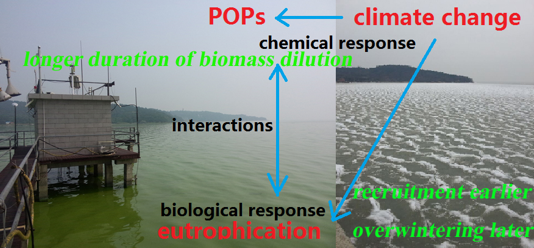Climate change is a global problem faced by human beings and ecosystems. To date effects of climate change on bioaccumulation and biomagnification of chemical pollutants in planktonic food webs have rarely been studied. Recruitments of plankton have shifted earlier due to global warming. Global warming and precipitation patterns are projected to shift seasonally. Whether and how the shifts in plankton phenology induced by climate change will impact bioaccumulation and biomagnification of chemical pollutants, and how they will respond to climate change are largely unknown.
Associate Professor Tao Yuqiang, Professor Xu Bin, Doctor Wang Zhen from Nanjing Institute of Geography and Limnology CAS, Associate Professor Lei Guoliang from Fujian Normal University, Doctor Liu Fei from Fuzhou Environmental Monitoring Station have made a new advance. They combine data analysis of the past seven decades, high temporal resolution monitoring and model development to test this hypothesis with nine polycyclic aromatic hydrocarbons (PAHs) in the planktonic food web of a subtropical shallow eutrophic lake in China. They find biphasic correlations between both bioconcentration factors and bioaccumulation factors of the PAHs and the mean temperature, which depend on the recruitment temperatures of cyanobacteria, and copepods and cladocerans. The positive correlations between bioconcentration factors, bioaccumulation factors and the mean temperature will be observed less than approximately 13–18 days by 2050–2060 due to the shifts in plankton phenology. The PAHs and their bioaccumulation and biomagnification will respond seasonally and differently to climate change. Bioaccumulation of most of the PAHs will decrease with global warming, with higher decreasing rates appearing in winter and spring. Biomagnification of most of the PAHs from phytoplankton to zooplankton will increase with global warming, with higher increasing rates appearing in winter and spring. Their study provides novel insights into bioaccumulation and biomagnification of chemical pollutants in eutrophic waters under climate change scenarios.

Recently research results have been published in the Environmental Pollution which is the main publication of the environmental science.
Paper link: http://www.sciencedirect.com/science/article/pii/S026974911631394X
This work has been supported by the National Natural Science Foundation of China, the outstanding member program of the Chinese Academy of Sciences youth innovation promotion association, the natural science foundation of Jiangsu province and the national foundation work.
(Information source: Nanjing Branch of CAS)

